The kitchen is the busiest spot of the homes, so its floors take the most beating. Kitchen floors must withstand heavy foot traffic, different spills, and the impact of dropped dishes and other kitchen paraphernalia. Besides that, these are some other considerations:
Style – If you are considering kitchen floors for a house to be built, it would set the mood of the whole kitchen. Choose the material and the color that would complement your planned kitchen style as a whole. It can be rustic, modern, country-style or contemporary. If you are renovating an existing kitchen, consider its size, as well as existing colors, patterns and textures. Decide if it would serve as a neutral backdrop or a vivid focal point.
Cost – The floor is just one aspect of the kitchen. If you are remodeling the kitchen, you have a lot of other expenses, like countertops, cabinets, lighting, stove upgrade, and more. How much you are willing to spend for the floor? Remember that additional costs may apply, including the labor for the removal and disposal of your previous floor, delivery and installation, as well as added costs for underlayment, moldings, thresholds, reducers and other accessories.
Ease of cleaning – Kitchen can get very dirty because of spills, dirt and food particles dropping. Minimize time, effort and money spent on maintenance by choosing a material that is liquid-resistant, easy to clean and not prone to staining.
Comfort – If you would spend a lot of time standing on your feet slicing, dicing, mixing and cooking, choose a floor material with a bit of softness and resilience. Whatever floor you choose, you can also add comfort by putting carpets, rugs or soft mat.
Household type and other considerations – Are you the type of home owner who would like to cook food a lot? Do you entertain guests very often? Do you have young children and/or pets inside the house? Does your kitchen get a lot of direct sunlight which can fade or darken floors in the long run? What type of climate does your hometown have? All these factors should be considered in choosing the best kitchen floor for your home.
FLOORING OPTIONS
Now, the kitchen can accommodate various types of flooring materials. To guide you in decision-making, we listed the best uses, as well as the pros and cons for each of the floor types:
 1. HARDWOOD
1. HARDWOOD
Hardwood flooring, with its timeless visual appeal, is an excellent choice. Its look never goes out of style, so it would give you a good return of investment if you would want to sell your home in the future. It suits virtually any kitchen style. It creates a warm and welcoming look.
Hardwood is an ideal choice if you seek durability. It can withstand decades of use and is low-maintenance. It’s also good if you want your kitchen to look dated over time.
This type of flooring is manufactured from timber. The stability, hardness, graining and color are determined by the specie of wood chosen. Oak is most common, but other options like maple, cherry, hickory, walnut and birch are also used. The colors could range from blond to caramel, burgundy to brown and even black. You can also choose from a huge range of shades and grains that can fit any setting and style. A uniform grain looks modern; while notches, adze marks and irregular patterns match a traditional scheme.
In cleaning hardwood floors, you have to wipe up spills immediately. Regularly dust, sweep and vacuum the floor and occasionally wipe the surface with a damp cloth or mop. Avoid using waxes, polishes, oil-based sprays and abrasive cleaners. It must also be protected from pets’ claws and high heels.
There are two types of hardwood flooring: solid or engineered.
A. Solid hardwood
Solid hardwood is made of real, single piece of wood. It can come pre-finished for easier installation, or unfinished for more stain options on finishing on-site. Pre-finished floors can hold up better than those finished on site. Usually, it is nailed or stapled to a wooden subfloor, but the very thin types are sometimes glued.
Pros: It is renewable, recyclable, sturdy, long-lasting and pleasing to the eyes. There would always be a wood that will look just right in your kitchen, whether thin strips of pale maple of wide planks of pine.
Solid wood can be sanded and refinished for several times, and it can be stained in a variety of colors. Natural wood also provides warmth with its insulation properties.
Cons: Wood may expand and contract due to varying levels of humidity and can dent easily. It is not recommended for damp spaces. Solid wood would also require a subfloor, which can make installation more expensive. It would also be dangerous to put underfloor heating in solid wood floors.
Wear and tear can easily show in high-traffic areas like the sink and hob. It can also dent and get scratched easily, so you would need refinishing periodically.
Cost: $5 to $10 per square foot
B. Engineered hardwood
A greener and more sustainable option, an engineered hardwood uses less milled lumber. It utilizes two lengths of wood veneer sandwiching a layer of birch fly. It’s the flooring material in between solid wood and laminate. Engineered hardwood floors almost always come pre-finished.
Pros: This flooring is a more cost-effective choice compared to solid hardwood, because it uses just a thin veneer of real wood. Engineered hardwood is also well-sealed and flat, making installation easier. It doesn’t expand or contract and can handle underfloor heating.
Cons: It dents and gets scratched easily, and can be refinished only once (some with a veneer to thin can’t even handle one refinishing). It also doesn’t wear as well as solid wood or laminate. It can also be noisy. Most of all, it lacks the character and feel of the real thing.
Cost: $3 to $12 per square foot
 2. LAMINATE
2. LAMINATE
Laminate flooring is generally cheaper than solid wood and engineered wood. This surface mimics the look of other materials – it is made of multi-layered material with an inner core made from high-density fiberboard and a high-resolution image of a surface like wood, stone, ceramic or other material, and a protective overlay covering on top.
People used to be a bit sniffy about laminates because sometimes style is being sacrificed for affordability. But today, there’s a wider range of good laminates to choose from. Yes, you still get what you pay for, but if you would invest for a pricier stuff, you can get fantastically sophisticated laminate floors that are so close to the original – even experts are having a hard time distinguishing high-end laminates from the real thing.
Pros: The durability of laminate also resists stains and scratches, making it perfect for a kitchen of a busy household that encounters frequent food spills of little kids and scratching of pets. It can resist moisture and discoloration from the sun’s rays. Laminates are also low-maintenance and doesn’t need sealing.
There are also realistic designs available for laminate flooring. If you want to achieve a certain look but you have not enough budget for it, laminates can save the day.
Cons: Laminate can be laid over wet systems, but not all are suitable for underfloor heating. You can touch up minor damages, but once the outer layer has worn through, you need to replace the flooring. It also needs an under layer, so you must ask before you buy if it is already attached to the laminate or not. Moisture and humidity can bring damage to laminate floors.
Cost: $3 to $7 per square foot, uninstalled
 3. VINYL
3. VINYL
If you are on a tight budget, you do a lot of cooking, and you want the floor that is easiest to maintain, it’s good to consider vinyl flooring. Vinyl is a popular flooring choice for kitchens. Like laminate, it offers a wide range of patterns and colors that imitate wood, stone, ceramics and other materials. Vinyl is also similar to linoleum, but the latter is not as durable or as soft.
Vinyl is composed of four layers: a felt of fiberglass backing, a printed design layer, a protective clear vinyl layer and a protective urethane top coat. It is made from a durable and versatile material called polyvinyl chloride (PVC). It comes in three different types: sheets, tiles and planks.
The thicker the vinyl, the sturdier it would be. The most affordable types are 80mm thick, and the premium products are available at about 155 mm. No matter what thickness, most vinyl floorings are cushioned and have a sophisticated design.
It can be installed over most existing floors. With proper preparation, vinyl can be installed over any flat, dry and clean surface. In most cases, it is recommended to put a plywood underlayment.
Pros: Besides affordability and variety of design options, vinyl flooring is easy to clean up. It is waterproof and stain proof. It requires no maintenance beyond sweeping and mopping. It is also good at fending off dents, wear, scratches and discoloration from sunlight. It is a good option if you have pets and young children.
This material is also shock-absorbent. A sheet vinyl is much more forgiving if someone in your family is a bit clumsy and tends to accidentally drop things, for you will experience less breakage. It’s also comfortable under foot, which is important when you have to stand for long periods.
Vinyl can be usually installed on your own, without help from a pro.
Cons: While vinyl flooring has a wear layer that helps resist scratches, it eventually wears off after about 20 years. It can also dent, bubble or curl over time. Vinyl can also emit harmful volatile organic compounds (VOCs) over time.
The extra cushiness of vinyl can make it hard to create seams that will stay tightly bonded over years. When seams come apart, it would let in moisture and trap dirt.
Also, even the best products that promise to mimic the look of tile, oak or stone can still look like vinyl up close. If you would choose luxury vinyl, it can cost as much as or more than the best laminate and solid hardwood floors.
Cost: $1 to $5 per square foot, uninstalled
 4. LINOLEUM
4. LINOLEUM
Linoleum is a staple through the first half of the 20th century, but it went out of fashion when synthetic flooring came into vogue. Nowadays, it’s making a comeback due to its eco-friendly and health-conscious qualities. This material is manufactured from natural products like wood flour, linseed oil, resin, cork dust, limestone and pigments. It is also available in a variety of colors and patterns that can suit any kitchen design.
Linoleum comes in several forms such as sheets, tiles and panels and squares. Sheets can be sleek and seamless, or accented with inlays and borders. Tiles come in several sizes and can be arranged in any way you want. Panels and squares provide design versatility, with easy locking installation. It is easy to install over any flat, dry and clean surface, but it is recommended to put a plywood underlayment for best results.
To clean linoleum floors, you only need to sweep, dust or vacuum regularly. At times, you may need to wipe it with damp cloth or a mop, using a pH-neutral cleanser. You may also need to buff it every few years as needed. A yellow cast may appear in the flooring as linseed oil oxidizes, but you can fend it off just by exposing it to sunlight or artificial light.
Pros: Like vinyl, linoleum is a durable surface that is soft and comfortable underfoot. It’s resistant to wear, scratch and dents. It’s affordable, versatile and easy to maintain.
Because it is available in a variety colors, designs and patterns, you can achieve a look that is different from the usual wood or tile look.
Linoleum is biodegradable, recyclable and free of harmful VOCs, since it is made from natural materials. It is also inherently antibacterial and anti-static, making it hygienic and hypo-allergenic.
Cons: Linoleum can be relatively expensive, plus its resistance to scratches, dents and wear varies widely from product to product. A protective coating is added by many manufacturers before the flooring is sold, but without this coating, you may need perioding waxing and polishing. It can also fade with time.
This flooring is also difficult to work with, so even experienced DIY-ers would need help from a pro.
Cost: $4 to $7 per square foot, uninstalled. Custom colors and patterns may cost more.
 5. CORK
5. CORK
A stylish floor option, cork comes in planks, tiles or sheets in a variety of colors. If you want a softer and an eco-friendly choice, cork flooring is the best for you.
Cork is made from tree bark harvested from the cork oak tree. The material is mixed and ground with resins. It’s a sustainable material that grows back, and can be harvested repeatedly.
Some cork floors are pre-finished, while others are finished upon installation. Finish options include wax, vinyl coatings and polyurethane. Cork flooring can be glued over flat surfaces like concrete and wood. When installing over existing floors, it is required to put a plywood underlayment at least ¼ inch thick. The thicker the cork, the denser and more durable the floor will be.
This type of flooring provides natural insulation, warmth, sound-proofing. It is naturally resistant to water, heat and mold. However, you need to keep floors free of sand and dirt as they can scratch the surface over time. When signs of wear appear, it’s an indication that it is time for refinishing.
Pros: Comfort-conscious cooks would love the softness and springiness of cork, which makes standing for long periods much easier. Its unique structure makes it waterproof and compressible, even if it is softer than most floors. If you drop your favorite chinaware, it can absorb the shock so that it won’t break. Its natural components also guard the floor against mold, mildew, allergens, insects and pests. Cork floors help reduce energy costs by being a natural insulator.
Cons: Because it can be scratched with dirt, you always need to keep it clean by constant sweeping and vacuuming. You also need to reseal it every three to four years with wax or polyurethane to help guard against scratches and prevent moisture from entering the seams.
The color of cork can also fade in strong sunlight. Your kitchen cabinets and refrigerator can leave an imprint on the floor over time, so make sure you place mats under them.
Cost: $2 to $12 per square foot, uninstalled
 6. BAMBOO
6. BAMBOO
Although it’s technically a grass, bamboo is more durable and harder than many types of wood. Bamboo flooring is becoming a new trend for kitchens because it blends style and durability. Its affordability relative to hardwood is another selling factor.
Bamboo comes in tiles or planks in different colors, sizes, patterns and textures. The primary color options for bamboo include natural (blond), stained and carbonized or caramelized. Bamboo flooring is also available in various construction styles such as horizontal, vertical and woven or stranded. The woven style, which is made from shredded strands of bamboo compressed with resin, is the hardest type available and the most exotically beautiful.
There must be a subfloor for a bamboo floor and it must be smooth. A waterproof underlayment is important if it would be installed over concrete since bamboo is prone to moisture.
Pros: Bamboo grows more quickly than wood, so it’s considered as a more sustainable flooring choice. It is springier underfoot, which makes it comfortable to stand on. It is durable, long-lasting and low-maintenance.
Cons: Even though bamboo is durable, it can dent and scratch, so it’s best to keep it away from pets’ claws – or better keep their nails clipped. It is also not as moisture-resistant as other kitchen flooring materials, and it can warp in high-humidity climates or spaces.
Cost: $4 to $9 per square foot, uninstalled.
 7. PORCELAIN
7. PORCELAIN
If you want the toughest flooring, go for porcelain. In fact, it’s so tough it can be used outdoors in any climate. Like ceramic, porcelain is made from natural clay, but denser. It is mixed with finely ground sand, making it more hard-wearing, scratch and chip-resistant, and less porous than ceramic.
If you want your kitchen to have the look of stone, choose from different porcelain tile designs available that would come either glazed or unglazed. Glazed tiles have a glass-like coating and can imitate the look and texture of a real stone minus the cost. The unglazed versions have natural earthy tones since they adopt the color of their clay mixture.
Pros: Porcelain tiles are virtually maintenance-free. It doesn’t need sealing and is very hard to scratch or chip. It is hygienic and can be washed with any type of cleaner. Tiles of this material are impervious to moisture and gather less dirt.
A wide range of options for styles, patterns and textures for porcelain tiles are available in the market. It’s very easy to install and easy to repair. Once it is chipped, you only have to replace the damaged tiles, not the whole floor. It is also compatible with underfloor heating.
Cons: Porcelain simply doesn’t have the warm charm of timber. It would be unforgiving to the feet if you would stand on them for too long, and it could go very cold without insulation.
Cost: $3 to $8 per square foot, uninstalled.
 8. CERAMIC
8. CERAMIC
The ceramic tile is the quintessential choice for kitchen flooring. You have practically limitless options for color, size, shape, texture and pattern for this type. Kitchen styles ranging from Old World to contemporary or modern can complement ceramic flooring.
Like porcelain, ceramic tiles are made of clay and can be glazed or unglazed. A rectified ceramic tile is highly recommended to avoid thicker ground lines, which gather dirt and grime.
Pros: Ceramic tiles are available in many different style, color and pattern options. It is super easy to clean up since it is resistant to spills, splashes and stains. This classic material also resists wear and tear, scratches and dents.
Cons: The tiles can crack and grout can stain with accumulated dirt. Once you drop a dish or glass in a ceramic floor, it is guaranteed to shatter. It can also be cold and hard underfoot.
Cost: $3 to $8 per square foot, uninstalled.
 9. STONE
9. STONE
Whether they’re made of limestone, slate, travertine or granite, natural stone flooring is a classic choice due to its variation. Because stones cannot have the exact same color, pattern and texture of another, it creates a unique look with distinct visual depth that is hard to replicate. It creates an elegant, gracious look that makes a kitchen feel more upscale and classy.
Stone flooring can’t be laid on a floating floor – it requires a strong level base.
Pros: Stone is beautiful and timeless. It makes a floor look high-class. It’s long lasting and easy to clean and maintain. It’s cool underfoot, which is great for hot climates, but it can handle underfloor heating as well.
Cons: Like porcelain and ceramic tiles, stone is not very forgiving to your feet if you would stand for so long. Once you drop fragile kitchenware, it would get cracked and broken easily. Without underfloor heating, it would be very cold, especially during winter.
Cost: $15 to $30 per square foot, uninstalled.
 10. CONCRETE
10. CONCRETE
Concrete is not the most popular choice and won’t suit everybody’s taste, but come on – it’s basic. If you’re going for an edgy aesthetic or an industrial chic look, concrete is the best pick. Whenever you hear “concrete,” an image of a dull gray surface might be forming in your mind, but it isn’t always the case. Today, concrete can be stained, dyed, scored, stamped, textured or acid-etched for your satisfaction.
This material is probably the most durable and long-lasting, for it can survive indefinitely and gets tougher with age. However, it can only be installed by professionals – otherwise you won’t get good results.
Pros: Concrete flooring can be created from an existing slab or newly poured material. It has natural thermal qualities that can absorb heat during the day and release it at night, but it is also compatible with underfloor heating. It’s very easy to clean and resistant to staining when properly sealed. In addition, since it is very tough and indestructible, you don’t have to worry about chips or scratches or pests that might harbor under the floors.
When stained or pigmented, concrete can transform into a beautiful stone-like appearance. Once you’ve get tired of it, you’ll have a ready subfloor for tiles or other materials.
Cons: When chipped or cracked (which can virtually be caused only by earthquakes, heavy impact or improper installation), you need to make a real effort in repairing it – but don’t expect it to look the same again. As with other hard materials, it can be cold and uncomfortable for the feet. If not sealed, it would be susceptible to staining from water, oil, spills and other accidents.
Cost: A basic concrete floor installed from scratch can amount from hundreds to thousands of dollars, depending on the size of the space and other considerations. Finishing treatments like staining and stamping cost around $2 to $15 or more per square foot.
11. BRICK
Being a big trend in garden homes, brick is being considered as a kitchen flooring option to achieve that vintage French rustic look. There is simply something homey about a brick floor that gives a warm and inviting feeling. However, it is only recommended on floors that have a high load-bearing capacity because of its weight. You might only want to install it on ground level floors since most buildings are not designed to handle the weight of brick on higher level floors.
Pros: The unique design and aura your kitchen could is the greatest advantage of brick flooring. It does not only come in red blocks placed in a row – there are actually a variety of design options available. Colors can range from soft tans to dark crimson hues, but there are color-stained and tinted bricks available in colors that are nowhere near red. Using different sized and shaped bricks can create a unique organic look.
This material also boasts of strength and durability, like most flooring materials. It is also a great insulator with its ability to retain heat very well. If the individual bricks would become damaged, like tiles, they can be replaced easily.
Cons: The biggest concern with brick flooring would be its porous characteristic. Water and other liquids can penetrate down the brick and cause damage to the subfloor. If you would choose brick for kitchen flooring, make sure the plumbing system in your kitchen is unbreakable. Its porousness could also cause the growth of bacteria and molds. Because of that, you need to use a sealing agent to the surface and reapply it every 6-12 months depending on the level of traffic in your kitchen.
The hardness of the brick can be a problem to the feet and legs when cooking. Since it is a heavy material, it would require a concrete subfloor for support, and a floating wooden subfloor before installation.
Cost: $5 to $10 per square foot
Whichever flooring options you choose, you need to buy coordinating mouldings, transitions and other accessories for your flooring project. It would be best to figure out the top rated kitchen floors and read more kitchen floor reviews to help in choosing a particular brand. Also look for great kitchen floor deals from your favorite home improvement center, because you might avail free installation, discounts and more.

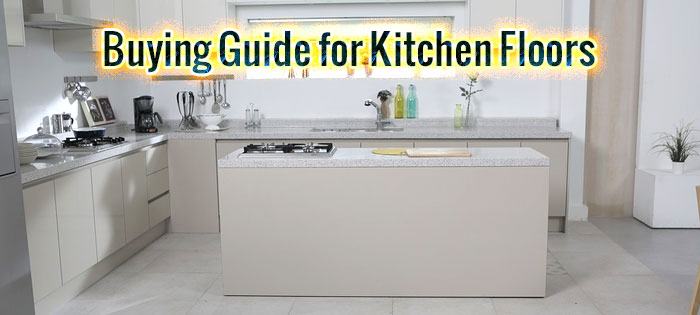
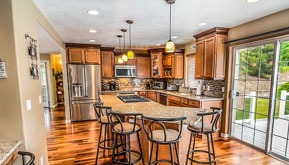 1. HARDWOOD
1. HARDWOOD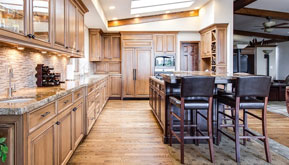 2. LAMINATE
2. LAMINATE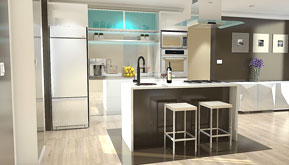 3. VINYL
3. VINYL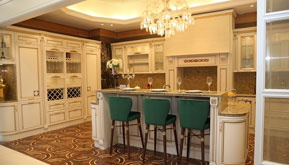 4. LINOLEUM
4. LINOLEUM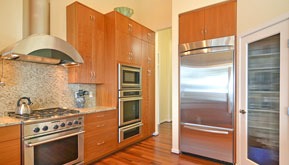 5. CORK
5. CORK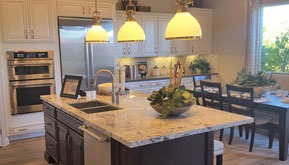 6. BAMBOO
6. BAMBOO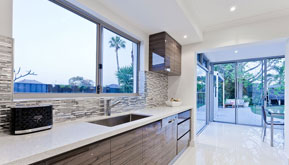 7. PORCELAIN
7. PORCELAIN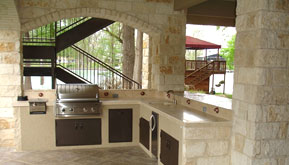 8. CERAMIC
8. CERAMIC 9. STONE
9. STONE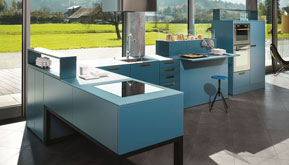 10. CONCRETE
10. CONCRETE